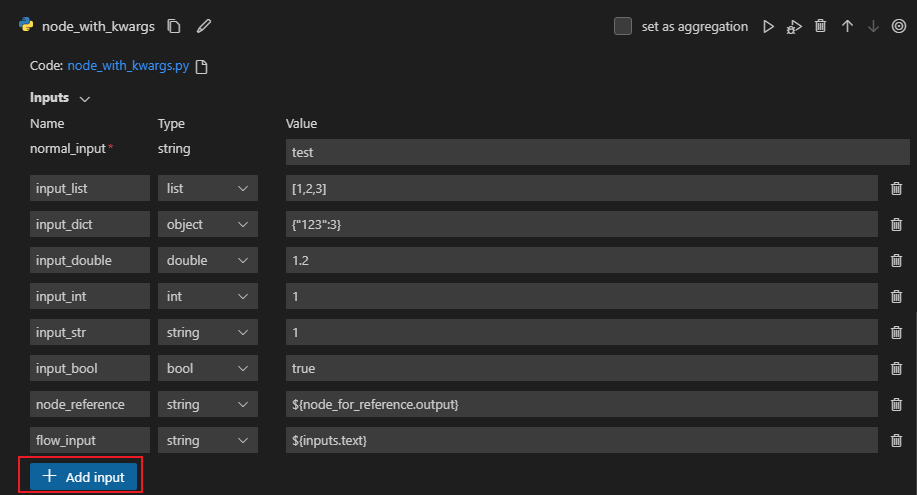Python#
介绍#
Python 工具使用户能够将自定义代码片段作为自包含的可执行节点在 PromptFlow 中使用。用户可以轻松创建 Python 工具、编辑代码并验证结果。
输入#
名称 |
类型 |
描述 |
必填 |
|---|---|---|---|
代码 |
字符串 |
Python 代码片段 |
是 |
输入 |
- |
工具函数参数及其赋值列表 |
- |
类型#
类型 |
Python 示例 |
描述 |
|---|---|---|
int |
参数: int |
整数类型 |
bool |
参数: bool |
布尔类型 |
字符串 |
参数: str |
字符串类型 |
双精度浮点数 |
参数: float |
双精度浮点数类型 |
列表 |
参数: list 或 参数: List[T] |
列表类型 |
object |
参数: dict 或 参数: Dict[K, V] |
对象类型 |
参数: CustomConnection |
连接类型,将特别处理 |
带有 Connection 类型注解的参数将被视为连接输入,这意味着
Promptflow 扩展将显示一个选择器来选择连接。
在执行时,promptflow 将尝试查找与传入参数值同名的连接。
请注意,Union[...] 类型注解仅支持连接类型,例如 param: Union[CustomConnection, OpenAIConnection]。
输出#
Python 工具函数的返回值。
如何编写 Python 工具?#
指南#
Python 工具代码应包含完整的 Python 代码,包括任何必要的模块导入。
Python 工具代码必须包含一个用 @tool 装饰的函数(工具函数),作为执行的入口点。@tool 装饰器应在代码片段中只应用一次。
以下示例定义了用 @tool 装饰的 Python 工具“my_python_tool”
Python 工具函数参数必须在“Inputs”部分赋值
以下示例定义了输入“message”并赋值为“world”
Python 工具函数应有返回值
以下示例返回一个连接的字符串
代码#
以下代码片段展示了工具函数的基本结构。Promptflow 将读取该函数并从函数参数和类型注解中提取输入。
from promptflow.core import tool
from promptflow.connections import CustomConnection
# The inputs section will change based on the arguments of the tool function, after you save the code
# Adding type to arguments and return value will help the system show the types properly
# Please update the function name/signature per need
@tool
def my_python_tool(message: str, my_conn: CustomConnection) -> str:
my_conn_dict = dict(my_conn)
# Do some function call with my_conn_dict...
return 'hello ' + message
输入#
名称 |
类型 |
Flow Yaml 中的示例值 |
传递给函数的值 |
|---|---|---|---|
message |
字符串 |
“world” |
“world” |
my_conn |
CustomConnection |
“my_conn” |
CustomConnection 对象 |
Promptflow 将在执行时尝试查找名为“my_conn”的连接。
输出#
"hello world"
关键字参数支持#
从 PromptFlow 1.0.0 版本和 适用于 VS Code 的 Prompt flow 1.4.0 版本开始,我们引入了对 Python 工具中关键字参数 (kwargs) 的支持。
from promptflow.core import tool
@tool
def print_test(normal_input: str, **kwargs):
for key, value in kwargs.items():
print(f"Key {key}'s value is {value}")
return len(kwargs)
当您在 Python 工具中像上面代码一样添加 kwargs 时,您可以通过 +添加 输入 按钮插入可变数量的输入。
